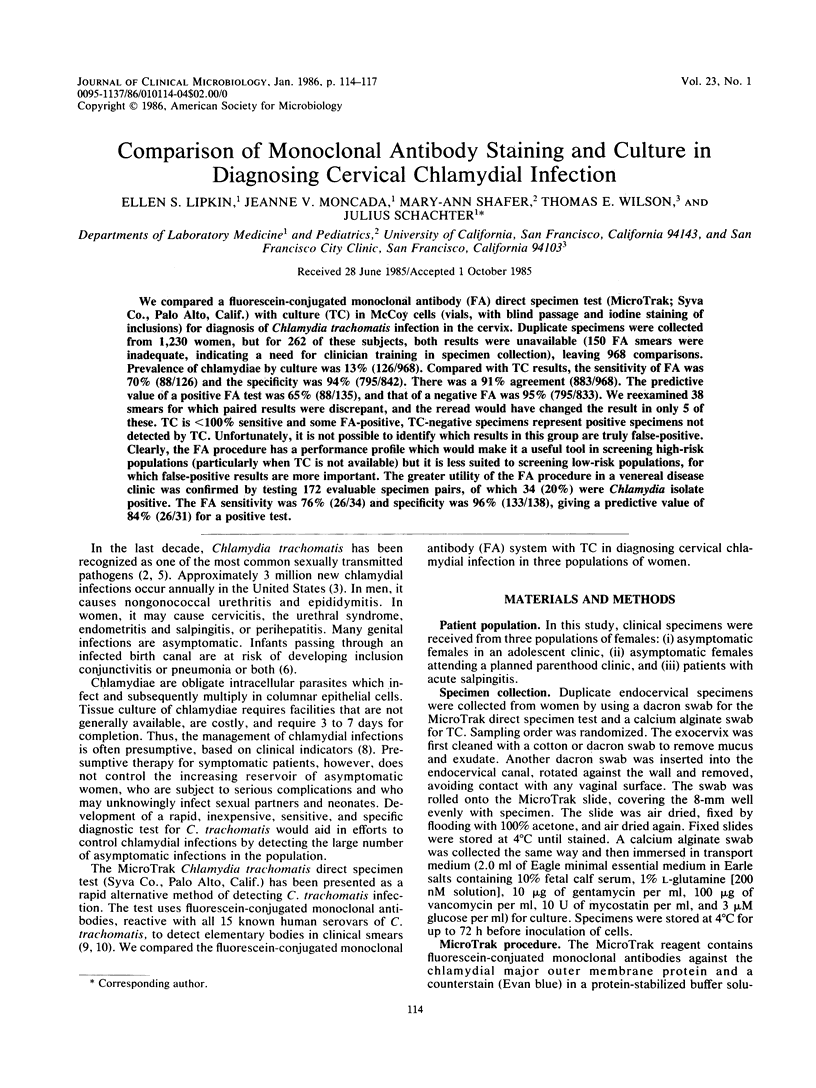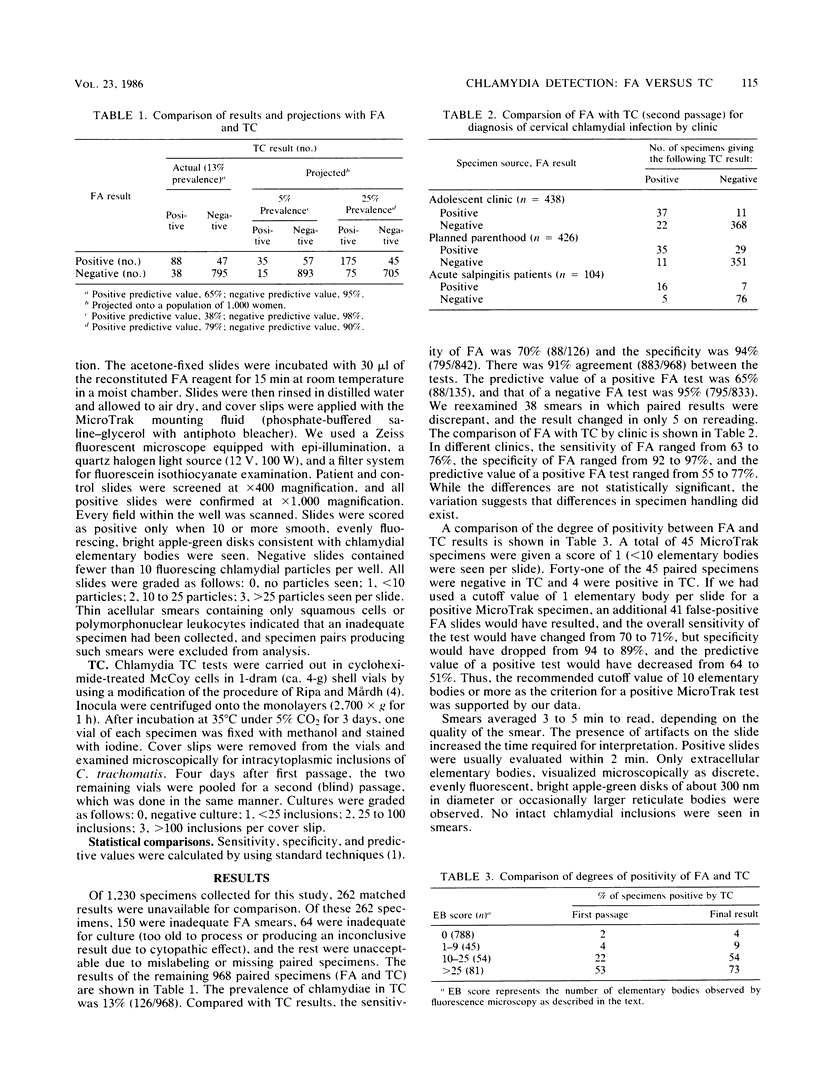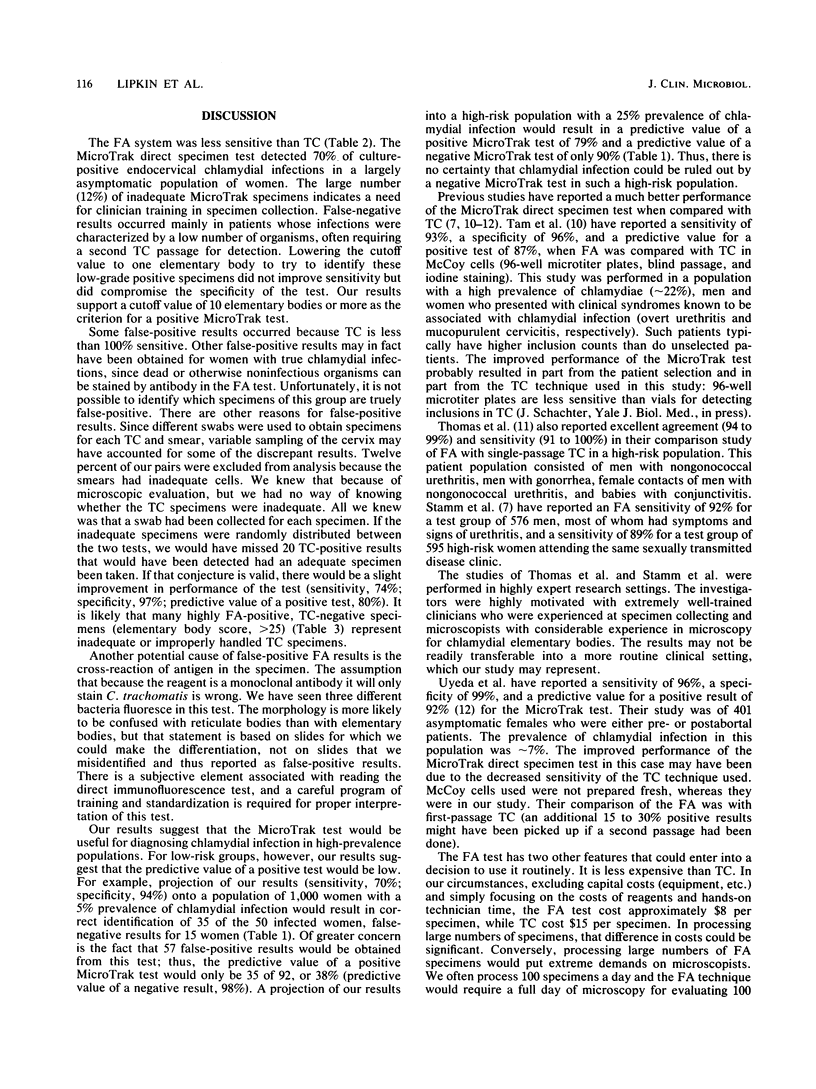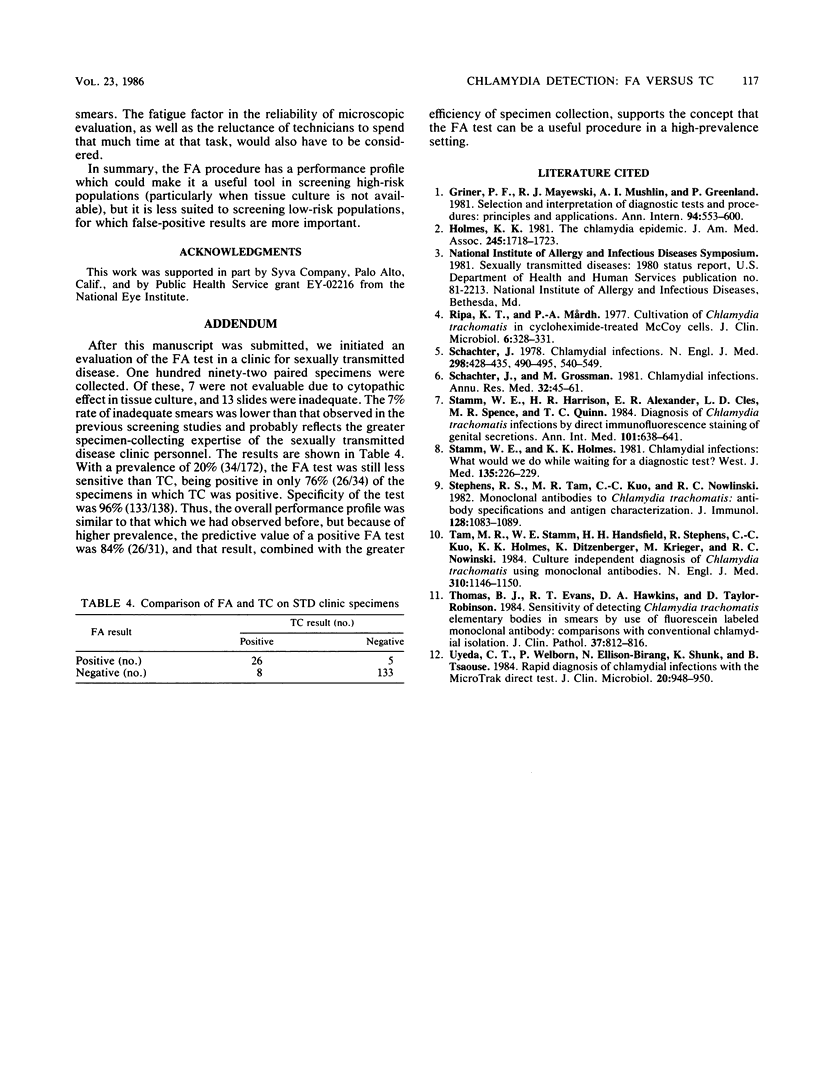Abstract
We compared a fluorescein-conjugated monoclonal antibody (FA) direct specimen test (MicroTrak; Syva Co., Palo Alto, Calif.) with culture (TC) in McCoy cells (vials, with blind passage and iodine staining of inclusions) for diagnosis of Chlamydia trachomatis infection in the cervix. Duplicate specimens were collected from 1,230 women, but for 262 of these subjects, both results were unavailable (150 FA smears were inadequate, indicating a need for clinical training in specimen collection), leaving 968 comparisons. Prevalence of chlamydiae by culture was 13% (126/968). Compared with TC results, the sensitivity of FA was 70% (88/126) and the specificity was 94% (795/842). There was a 91% agreement (883/968). The predictive value of a positive FA test was 65% (88/135), and that of a negative FA was 95% (795/833). We reexamined 38 smears for which paired results were discrepant, and the reread would have changed the result in only 5 of these. TC is less than 100% sensitive and some FA-positive, TC-negative specimens represent positive specimens not detected by TC. Unfortunately, it is not possible to identify which results in this group are truly false-positive. Clearly, the FA procedure has a performance profile which would make it a useful tool in screening high-risk populations (particularly when TC is not available) but it is less suited to screening low-risk populations, for which false-positive results are more important. The greater utility of the FA procedure in a venereal disease clinic was confirmed by testing 172 evaluable specimen pairs, of which 34 (20%) were Chlamydia isolate positive. The FA sensitivity was 76% (26/34) and specificity was 96% (133/138), giving a predictive value of 84% (26/31) for a positive test.
Full text
PDF



Selected References
These references are in PubMed. This may not be the complete list of references from this article.
- Holmes K. K. The Chlamydia epidemic. JAMA. 1981 May 1;245(17):1718–1723. [PubMed] [Google Scholar]
- Ripa K. T., Mårdh P. A. Cultivation of Chlamydia trachomatis in cycloheximide-treated mccoy cells. J Clin Microbiol. 1977 Oct;6(4):328–331. doi: 10.1128/jcm.6.4.328-331.1977. [DOI] [PMC free article] [PubMed] [Google Scholar]
- Schachter J. Chlamydial infections (third of three parts). N Engl J Med. 1978 Mar 9;298(10):540–549. doi: 10.1056/NEJM197803092981005. [DOI] [PubMed] [Google Scholar]
- Schachter J., Grossman M. Chlamydial infections. Annu Rev Med. 1981;32:45–61. doi: 10.1146/annurev.me.32.020181.000401. [DOI] [PubMed] [Google Scholar]
- Stamm W. E., Harrison H. R., Alexander E. R., Cles L. D., Spence M. R., Quinn T. C. Diagnosis of Chlamydia trachomatis infections by direct immunofluorescence staining of genital secretions. A multicenter trial. Ann Intern Med. 1984 Nov;101(5):638–641. doi: 10.7326/0003-4819-101-5-638. [DOI] [PubMed] [Google Scholar]
- Stamm W. E., Holmes K. K. Chlamydial infections. What should we do while waiting for a diagnostic test? West J Med. 1981 Sep;135(3):226–229. [PMC free article] [PubMed] [Google Scholar]
- Stephens R. S., Tam M. R., Kuo C. C., Nowinski R. C. Monoclonal antibodies to Chlamydia trachomatis: antibody specificities and antigen characterization. J Immunol. 1982 Mar;128(3):1083–1089. [PubMed] [Google Scholar]
- Tam M. R., Stamm W. E., Handsfield H. H., Stephens R., Kuo C. C., Holmes K. K., Ditzenberger K., Krieger M., Nowinski R. C. Culture-independent diagnosis of Chlamydia trachomatis using monoclonal antibodies. N Engl J Med. 1984 May 3;310(18):1146–1150. doi: 10.1056/NEJM198405033101803. [DOI] [PubMed] [Google Scholar]
- Thomas B. J., Evans R. T., Hawkins D. A., Taylor-Robinson D. Sensitivity of detecting Chlamydia trachomatis elementary bodies in smears by use of a fluorescein labelled monoclonal antibody: comparison with conventional chlamydial isolation. J Clin Pathol. 1984 Jul;37(7):812–816. doi: 10.1136/jcp.37.7.812. [DOI] [PMC free article] [PubMed] [Google Scholar]
- Uyeda C. T., Welborn P., Ellison-Birang N., Shunk K., Tsaouse B. Rapid diagnosis of chlamydial infections with the MicroTrak direct test. J Clin Microbiol. 1984 Nov;20(5):948–950. doi: 10.1128/jcm.20.5.948-950.1984. [DOI] [PMC free article] [PubMed] [Google Scholar]


